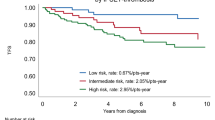Abstract
In an international study of 1104 patients with essential thrombocythemia (ET), a histological review according to the 2008 World Health Organization (WHO) criteria confirmed ET in 891 patients (WHO-ET, 81%), and revised the diagnosis to prefibrotic primary myelofibrosis (PMF) in 180 patients (PMF, 16%). Major bleeding during follow-up occurred in 55 (6%) WHO-ET and 21 (12%) PMF patients (P=0.009), at a rate of 0.79 and 1.39% patients per year, respectively, (P=0.039). In a multivariable analysis, predictors of bleeding included diagnosis of PMF (P=0.05; hazard ratio (HR) 1.74), leukocytosis (P=0.04; HR 1.74), previous hemorrhage (P=0.025; HR 2.35) and aspirin therapy (P=0.001; HR 3.16). The analysis restricted to patients with WHO-ET confirmed previous hemorrhage (P=0.043; HR 1.92) and aspirin (P=0.027; HR 2.24) as independent risk factors. The current study reveals that major bleeding associated with thrombocytosis might be relatively specific to PMF, as opposed to WHO-defined ET. Furthermore, it shows that low-dose aspirin exacerbates these hemorrhagic events of PMF. In contrast, thrombocytosis per se was not a risk factor for bleeding; however, low-dose aspirin had a synergistic hemorrhagic effect unmasking the bleeding tendency of patients with extreme thrombocytosis. These observations carry significant therapeutic implications in these two WHO entities.
This is a preview of subscription content, access via your institution
Access options
Subscribe to this journal
Receive 12 print issues and online access
$259.00 per year
only $21.58 per issue
Buy this article
- Purchase on Springer Link
- Instant access to full article PDF
Prices may be subject to local taxes which are calculated during checkout
Similar content being viewed by others
References
Epstein E, Goedel A . Hämorrhagische thrombocythämie bei vasculärer schrumpfmilz. Virchows Arch f path Anat Physiol f klin Med 1934; 292: 233–248.
Wolanskyj AP, Lasho TL, Schwager SM, McClure RF, Wadleigh M, Lee SJ et al. JAK2V617F mutation in essential thrombocythemia: clinical associations and long-term prognostic relevance. Br J Haematol 2005; 131: 208–213.
Alvarez-Larran A, Cervantes F, Pereira A, Arellano-Rodrigo E, Pérez-Andreu V, Hernandez-Boluda J-C et al. Observation versus antiplatelet therapy as primary prophylaxis for thrombosis in low-risk essential thrombocythemia. Blood 2010; 116: 1205–1210.
Elliott MA, Tefferi A . Thrombosis and haemorrhage in polycythaemia vera and essential thrombocythaemia. Br J Haematol 2005; 128: 275–290.
Murphy S, Peterson P, Iland H, Laszlo J . Experience of the Polycythemia Vera Study Group with essential thrombocythemia: a final report on diagnostic criteria, survival and leukemic transition by treatment. Semin Hematol 1997; 34: 29–39.
Vardiman JW, Harris NL, Brunning RD . The World Health Organization (WHO) classification of the myeloid neoplasms. Blood 2002; 100: 2292–2302.
Tefferi A, Thiele J, Orazi A, Kvasnicka HM, Barbui T, Harrison CA et al. Proposals and rationale for revision of the World Health Organization diagnostic criteria for polycythemia vera, essential thrombocythemia, and primary myelofibrosis: recommendations from an ad hoc international expert panel. Blood 2007; 110: 1092–1097.
Barbui T, Thiele J, Passamonti F, Rumi E, Boveri E, Ruggeri M et al. Survival and disease progression in essential thrombocythemia are significantly influenced by accurate morphologic diagnosis: an international study. J Clin Oncol 2011; 29: 3179–3184.
Carobbio A, Thiele J, Passamonti F, Rumi E, Ruggeri M, Rodeghiero F et al. Risk factors for arterial and venous thrombosis in WHO-defined essential thrombocythemia: an international study on 891 patients. Blood 2011; 117: 5857–5859.
Harrison CN, Campbell PJ, Buck G, Wheatley K, East CL, Bareford D et al. Hydroxyurea compared with anagrelide in high-risk essential thrombocythemia. N Engl J Med 2005; 353: 33–45.
Campbell PJ, Bareford D, Erber WN, Wilkins BS, Wright P, Buck G et al. Reticulin accumulation in essential thrombocythemia: prognostic significance and relationship to therapy. J Clin Oncol 2009; 27: 2991–2999.
Thiele J, Kvasnicka HM, Vardiman JW, Orazi A, Franco V, Gisslinger H et al. Bone marrow fibrosis and diagnosis of essential thrombocythemia. J Clin Oncol 2009; 27: e220–e221.
Moxon-Emre I, Schlichter LC . Neutrophil depletion reduces blood-brain breakdown, axon injury, and inflammmation after intracerebral hemorrhage. J Neuropathol Exp Neurol 2011; 70: 218–235.
Fang H, Sun C, Xu L, Owen RJ, Auth RD, Snoy PJ et al. Neutrophil elastase mediates pathogenic effects of antrax lethal toxin in the murine intestinal tract. J Immunol 2010; 185: 5463–5467.
Harrison C, Barbui T . Aspirin in low-risk essential thrombocythemia, not so simple after all? Leuk Res 2011; 35: 286–289.
Acknowledgements
Alessandro M Vanucchi at the University of Florence and investigators at the University of Pavia and at the Ospedali Riuniti di Bergamo were supported by a grant from Associazione Italiana per la Ricerca sul Cancro (AIRC, Milano) ‘Special Program Molecular Clinical Oncology 5 × 1000’ to AGIMM (AIRC-Gruppo Italiano Malattie Mieloproliferative).
Author information
Authors and Affiliations
Corresponding author
Ethics declarations
Competing interests
The authors declare no conflict of interest.
Rights and permissions
About this article
Cite this article
Finazzi, G., Carobbio, A., Thiele, J. et al. Incidence and risk factors for bleeding in 1104 patients with essential thrombocythemia or prefibrotic myelofibrosis diagnosed according to the 2008 WHO criteria. Leukemia 26, 716–719 (2012). https://doi.org/10.1038/leu.2011.258
Received:
Revised:
Accepted:
Published:
Issue Date:
DOI: https://doi.org/10.1038/leu.2011.258
Keywords
This article is cited by
-
One thousand patients with essential thrombocythemia: the Mayo Clinic experience
Blood Cancer Journal (2024)
-
Correlation between IPSET-t risk at diagnosis and subsequent hemorrhage in patients with essential thrombocythemia; a single institution experience
Annals of Hematology (2024)
-
Distinct clinico-molecular arterial and venous thrombosis scores for myeloproliferative neoplasms risk stratification
Leukemia (2024)
-
Prediction of major bleeding events in 1381 patients with essential thrombocythemia
International Journal of Hematology (2023)
-
Essential Thrombocythemia in Adolescents and Young Adults: Clinical Aspects, Treatment Options and Unmet Medical Needs
Current Treatment Options in Oncology (2023)



